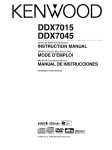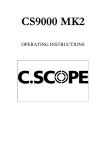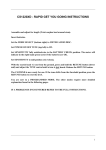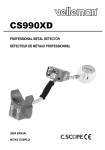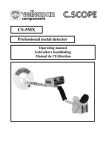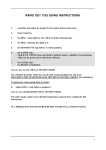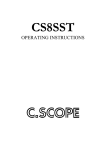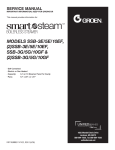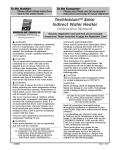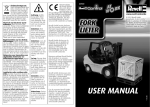Download C-SCOPE PROMET3 Instruction manual
Transcript
[;)ffi@ZJ[3L1~ OPERATING INSTRUCfIONS CONTENTS: 1 INTRODUCTION 2 ASSEMBLING YOUR PROMET 3 2·3 BATTERIES GETTING STARTED WITH YOUR PROMET 3 4 CONTROLS: On/Off Tune 4 Sensitivity 4 Ground Exclude 5 Retune Status 5 Auto Tune 5 Battery Check 5 Meter/Audio Discriminate 6 OPERATING YOUR PROMET 3: Pinpointing 7 7 Detection Range Target Size and Depth 7 The Right Approach 8 METAL DETECTING AND THE LAW 9 10 CODE OF CONDUCT 10 • 11 CARE AND MAINTENANCE 11 FURTHER INFORMATION INTRODUCTION The C-Scope PROMET 3 is the culmination of many years of research by both electronic engineers and metal detector enthusiasts to produce a detector with high performance, that both a novice or experienced user can harness to the full, simply and effectively. Important. To protect your investment complete the enclosed guarantee card and return the reply paid portion to C-Scope. This is particularly important in order to obtain the free second year parts guarantee. Please retain the original packing box. In the event that your detector should ever require to be serviced, this package will be most suitable for postal protection. C-Scope detectors are recognised as the finest detectors available. They are designed with lasting quality in mind, high technology, and above all, value for money. The only way to realise this value is to carefully study and understand this instruction manual. You will then be able to obtain all of the advantages designed into your detector. It is also strongly recommended that you experiment with the detector's operation in air, with various test samples, in order to learn to identify and understand the detector's capabilities and responses. Always remember that becoming a good metal detective is like becoming a good photographer or fisherman. Although it is an advantage to buy the best equipment, having bought it, patience and hours of practice are needed to become proficient. D A. Height Adjusting Stem Lock B. Upper Stem C. Knurled Nut (i) D. Middle Stem E. Knurled Nut (ii) F. Lower Stem G. Friction Boot H. Din Plug I. Cable J. Search Head Lugs K. Search Head F.astener L. Headphone Socket M. Din Socket N. Recharge Socket ASSEMBLING YOUR PROMET 3 Assembly of the PROMET 3 requires no special tools. 1. Remove the various parts from the box (the lower stem is already inserted into the middle stem) and lay on a clear surface as shown in the diagram below. 2. Unscrew the locking nut and remove the screw from the search head. Insert the lower stem between the lugs of the search head so the holes in the stem, friction boot and lugs are aligned. 3. Insert the head screw from the same side that the cable enters the search head and tighten the locking nut. Do not tighten with pliers or tools as this can cause over stress to the lugs. It is advisable to release the tension on the nut when the machine is not in use. 4. Hand tighten the knurled nut between the middle and lower stem. An olive insert ensures a tight grip is achieved. 5. Slacken the knurled nut on the handle stem and insert the middle stem by depressing the spring stud and locating the stud into one of the four hole positions depending on stem length required (the lower hole is ideal position for use when transporting your machine). 6. Hand tighten both the knurled nuts. 7. Wrap the head cable tightly around the stem and insert the plug into the socket under the handle. ti) It LOCKING NUT KNURLED NUT / LOWER STEM ~ FRICTIO~T ~~~.•- ~\_D' HEIGHT ADJUSTING STEM LOCK BATTERIES 2 / SPRING STUD MIDDLE STEM 1iJ / SEARCH HEAD I 7 HEAD SCREW The PROMET 3 is powered byeither: a) 12 HP7 Penlight Balleries (not supplied) in 2 six-pack battery holders (supplied with detector) or, b) 2 rechargeable packs (an optional accessory). HP7s are standard batteries and are available from garages, department stores, etc. Rechargeable batteries in two packs, together with a charger are available as a C-Scope Accessory. It is advised that standard HP7s are used to begin with. You can then evaluate the sort of use you give the detector and decide whether the investment in rechargeables is justified. Battery life is dependent on many things and is difficult to generalise on. The PROMET 3 is designed in such a way that the audio discriminate only draws significant extra current when a good object is located. It is certainly recommended that headphones are used as not only does this guarantee better depth penetration but it also extends battery life substantially. R O. P. a. Battery Compartment Penlight Battery Holders Battery Leads R. S. , S Battery Cover Fastener The loudspeaker is by far the greatest drain on the batteries. If HP7 batteries are to be used it is necessary to load these into the penlight battery holders which are supplied with the detector in the battery compartment. First undo the battery cover by turning the fastener with a small coin through 90 0 . This frees the fastener and releases the cover, which can then be lifted off. Load the battery holders ensuring that the batteries are inserted the correct way round with the + and - signs on the batteries corresponding with those engraved on the battery holders. After inserting the batteries roll them in the holders to make a good connection. Connect the battery holders to the battery leads in the battery compartment. Make sure the connection is firm and well seated, and place the holders in the battery compartment. Replace the battery cover by locating the two lugs first, and then pushing the end with the fastener home. It may be necessary to align the fastener before pushing it home. Batteries should not be left in the detector if the detector is stored or not used for long periods, thus avoiding possible leakage and expensive repairs. Battery Check & Charging As a guide to battery condition a Battery Check facility is provided. To check the batteries switch on the detector at the ON/OFF TUNE Switch and tune the detector by turning this control clockwise, with the RETUNE STATUS button depressed. Once the detector is set at the central Tune position release the RETUNE button and then depress the battery check button. If the needle on the meter swings into the bold red sector the batteries are in good condition. Should the needle not reach this sector of the meter and retain its level, the batteries need replacing. When rechargeable batteries are checked the meter needle will not reach full scale, but will maintain the same 2/3 scale reading for the life of the charge. Standard HP7s will discharge gradually, reading full scale when new and at the lower end of the bold red sector when discharged to 6 volts. Sometimes faulty batteries will initially give a good battery check, but will quickly discharge after a half-hour or so of use. When battery voltage falls below the necessary level symptoms will be: erratic signal, meter signal latching on full, signal drift etc. Always check and replace batteries if these symptoms occur. Rechargeable Battery Charging It is not necessary to remove the rechargeable packs for recharging. A recharge socket is provided so that the batteries can be recharged in the detector. Normal HP7s cannot of course be recharged. 3 GETTING STARTED WITH YOUR PROMET 3 After assembly and ballery insertion the PROMET 3 is now ready for operation. The PROMET 3 is extremely simple to operate, and is programmed and designed in such a way that the operator is not required to adjust discriminate or ground exclude levels. All that is required is to turn the detector ON at the ON/OFF TUNE control and tune the detector to threshold, as described below, and then programme the mode of operations. Here's how: Tuning Turn the detector ON at the ON/OFF TUNE control which works in conjunction with the RETUNE bullon on the meter console. Hold the RETUNE STATUS button down, and rotate the Tune control clockwise until the meter reaches the central Tune position, and the sound is just beginning to break through. Set this carefully and precisely and then release the memory RETUNE STATUS push bullon. If the Tuning level alters or wanders off tune, do not adjust the TUNE control. Simply operate the RETUNE STATUS push bullon which will automatically re-tune the detector to the original selected level. Programme Set To begin detecting, first tune, then set the controls as follows: Sensitivity - 0 Ground Exclude - G2 or Beach Auto Tune - ON Audio Discrim. - ON Meter Discrim. - ON Even greater depth will be achieved by leaving the Audio Discriminate off as this control tends to draw extra current when a good object is located, as explained on page 2. The RETUNE STATUS bullon will indicate which modes are engaged and operational. The AUTO TUNE button can be turned off once the machine has been operated for 30 minutes (except on the beach). The detector is now excluding the ground at a pre-set level on one channel and discriminating at a programmed level on the other channel. All metal objects will be indicated by an increase in loudness but rejected objects will cause the meter to fall to the left and the tone frequency to decrease. Accepted targets will conversely cause the meter to rise to the right or remain stationary and the tone frequency to increase. Simply sweep the detector in an arc, ensuring the head is level and as close to the ground as possible. Advance half a head length at a time, and ensure the tuning level is correctly set by raising the head an inch or two, depressing the RETUNE STATUS push bUllon, and then lower the head and continue. For a more detailed description of the CONTROLS AND WHAT THEY DO, read on, but if you follow the programmed method, outlined above, you cannot go far wrong. 4 CONTROLS AND WHAT THEY DO The controls are divided into two areas. Those on the Main Control Box of which there are three controls and those on the Meter Console where there are five function switches (four with associated lights) located below the meter. Meter Console Functions AUTO TUNE, METER DISCRIMINATE and AUDIO DISCRIMINATE are pressed to engage function, press again to disengage. RETUNE STATUS and BATIERY CHECK are momentary switches. Hold down to engage function, release to disengage. On/Off Tune See Tuning above. Sensitivity The SENSITIVITY CONTROL regulates the sensitivity of the detector to drift, instability etc., as well as to metal objects. The recommended starting point is o and highlighted in red. Increasing the Sensitivity by tuning this control into the + sector the detector will be more prone to drift, erratic signals, ground interfaces, etc. Where there is no ground effect or outside interference the SENSITIVITY control can be operated at higher levels. But when the signal becomes unsteady or erratic, the Sensitivity level should be reduced to obtain a clear, steady tuning threshold. Only when the tuning is constant and steady will the detector operate at the best optimum depth penetration. T. On/Off Tune U. Sensitivity V. Ground Exclude W. Auto Tune X. Y. Z. Battery Check Retune Status Meter Discriminate a. Audio Discriminate Ground Exclude The G2 GROUND EXCLUDE selling is designed to cope with even the most severely mineralised sites. This setting is marked in red as it is most frequently needed. However, you may need to select either G1 or G3 under the following circumstances: Select G2 Lower the search head to the ground from approximately 50cm away. If the meter needle remains central and the threshold tone stable then search in G2 after selecting the desired automatic discrimination. If, when the search head is lowered, an increase in sound is heard and the needle deflects to the right, then select G1. If alternatively, a decrease in sound is experienced and a left deflection of the needle then change to G3. It is as easy as that. Retune Status When operated, this control acts as a memory re-tune bullon as described under Tuning (pA). It also indicates which Meter Console mode is engaged by lighting a red LED over any mode which is on. Auto Tune Auto Tune maintains the threshold set by the tune control and is particularly useful in the first 30 minutes of searching whilst the machine is warming up or in adverse ground cOAditions such as the beach. Battery Check See Battery Check and Charging (p.3). 5 Meter/Audio Discriminate The levels of Discrimination or Rejection are identical in both modes Meter and Audio (Discrimination c;an be defined as the ability to give a different type of signal for ferrous junk or worthless objects than the signal given by a non ferrous object). Both these Discriminate Modes are set at such a level, so that depth penetration to coins etc. is good, and discrimination against most iron and silver foil is achieved. A precise level of discrimination is selected to give maximum discrimination, without affecting sensitivity to coins, etc. Pull tabs, large silver foil, or large iron will not be rejected, because the levels of discrimination required to reject these also reduce the depth penetration to certain non-ferrous metals and thin section objects. It is not possible to reject a valuable object with the PROMET 3's AUDIO or METER DISCRIMINATION Modes, if the object is in range. You should now experiment with various coins, iron and silver foil to test the reaction of the various objects so that you will be able to correctly interpret the signals. Hang the detector over a table so that the search head is not near metal. Set the detector to the programmed levels as described, then pass objects across the search head. The signal is separated into two channels. One will signal the presence of all metals by giving an increase in loudness. The second is the Discriminate Channel and will function either as a METER DISCRIMINATOR or an AUDIO DISCRIMINATOR or both. In METER DISCRIMINATE - The meter will analyse the object. For a bad object the meter signal will decrease towards the left hand "reject" position. For a good object the meter signal will increase towards the right hand "accept" position or remain still. In AUDIO DISCRIMINATE - The pitch of the sound alters to analyse an object. A decrease in pitch signals a bad object. An increase in pitch or no change signals a good object. In practice the operator concentrates on careful sweeping of the search head in large arcs, keeping the search head near to the ground and level. When a signal is received, the operator can then take the search head away from the influence of the object, hold it steady at the operating height, carefully retune the detector and then carefully re-scan the object to analyse and pinpoint the object. With practice, this procedure becomes automatic, and various c;ombinations of audio and meter discriminate can be used to fully analyse doubtful objects. If in doubt, dig. All Metal Detection If all metals are required to be detected or iron is the target i.e. pipe or cable location, do not utilise AUDIO or METAL discriminate. Set to BEACH or G2 depending on the site. AUTO is recommended for ALL METAL DETECTION. When used in the All-metal Mode the PROMET 3 will detect all metals and will not discriminate. However, in the Meter and Audio Discriminate Modes the PROMET 3 has been programmed to operate at a fixed discriminating selling. It is recommended that all objects that are not rejected should be dug, i.e. if the meter needle does not dip or the audio pitch is inconclusive, dig the object. Iron, unlike a coin, occurs in a mL'ltitude of shapes and sizes. As a result it is possible that large pieces of iron may give a positive reading. Iron in the shape of nails or pieces of wire also may be present on the surface of a site. In this case anomalies in discrimination may occur. Anomalies or confusing signals can only occur in the first few inches away from the search head, and are characterised by a double signal from the same object, usually iron, which often ranges from a strong positive to a strong negative signal. To overcome these problems simply raise the search head and re-scan until a clear signal of rejection or acceptance is obtained. OPERATING YOUR PROMET 3 6 To test for the type of signal you will get, take a coin or metal object and with the detector set up on a table tuned as previously described, move the metal object towards and across the search head. You will note that the volume will increase quickly as the metal object passes across the search head, with the loudest sound occuring when the search head is immediately centred over the metal object. As the object passes beyond the search head the sound will quickly fade. Since the detectors employ a Total Response search head the object can be detected across the full width, back to front, of the search head. Maximum sensitivity occuring down the middle of the search head. Pinpointing (i) The strongest signal will always be received when the object is directly beneath the centre of the head (see X in Diagram 1). To pinpoint the find, stop the search head when you are directly over the target object, then move the search head through 90" and sweep again, thus forming a cross with the two sweeps. (ii) To 'focus' the target signal further raise the search head, retuning if necessary, and pass the search head over the object until only a faint signal is heard. The faint signal will then be occurring at point X under the centre of the head. More accurate pinpointing, particularly of deeply buried objects can be achieved by finding the centre of the target object as described above and fixing its position in the 'minds eye'. Turning your detector through 90" and sweeping across the target again will give a second reading, accurately determining the centre of the object. Digging carefully at point X will reveal the find. With little practice, size, shape and depth of an article may be estimated in this way before digging. DIAGRAM 1 Detection Range Detection ranges will vary depending on the size of the object, the length of time an object has been buried, and the type of ground the object is buried in. The best ground conditions are well compacted soils and coins can be found at the greatest depths if the object has been buried for some time and the coin has interacted with the salts in the ground, thereby appearing larger to the detector. The worst conditions for detecting are on loosely compacted or freshly dug ground or when the object has only recently been buried. In these conditions detection range will be reduced. 90% of all artefacts are found within 6" of the surface. N.B. Adverse soil conditions can reduce depth of detection by more than half. Determining the Target Size and Depth An operator who is familiar with his instrument will be able to do an excellent job of determining object size, shape, and depth before he digs. This technique is learned from careful analysis of the audio signals coming from the detector. Each time a signal is heard, listen for any peculiar characteristics it may have, determine over how large an area you get a detector signal, and try to "outline" the object before you dig. Listen for the sharpness or dullness of the signals and determine the magnitude of strength of the signal. A coin for example will have a sharp signal, a nail a fuzzy signal. After digging up the object, compare the object size, shape, depth and position in the grouno with signal information you received before digging. After careful analysis of many digs, you will learn to "read" the hidden target before digging. 7 The Importance of the Right Approach Treasure hunting can be a profitable and rewarding hobby, if approached in a patient and diligent manner. Time spent researching to locate a worthwhile site for a search can be time wasted if your search is hasty and erratic. To achieve maximum results it is important then, to decide on your approach to any particular site in advance of the actual search. Tactics will be decided by the type of site - it is more profitable to scan a small area thoroughly, than to conduct a haphazard search of the total site. However, when the site is too far away for you to make several return visits a plan should be adopted which gives maximum site coverage, at the same time as indicating the most likely area for detailed search. Your detector alone is not a guarantee of successful treasure hunting. Any detector needs an operator and for the best results the operator needs the right approach, attitude and technique. Too many beginners neglect the importance of pre-planning and research before using their detector in the field, and patience and technique during the actual search. A successful search should begin with research sometime before the day of the actual search. The extent and thoroughness of your research will be one of the major factors in the success of your detecti:1g. You should aim to get as complete an understanding as possible of the local history and geography. The key to the choice of the site is to think of people, where they congregated over the past few hundred years. What were their customs and pursuits? Where did they spend money? Where did they carry money? The answers are not Roman sites, nor are they associated with mystic treasure stories of crocks of gold. Rather, they are unassuming, undramatic places, like public footpaths and ancient rights of way, old houses and so on. When you have chosen your site, allocate a whole day from early morning to early evening for the search. Make sure that you have all equipment you are likely to need. Your detector should be checked before starting out, and you should always carry a spare set of batteries. You will also need a strong, sharp trowel. It is also a good idea to have a set of lines and pins so that you can layout your search area scientifically. Most beginners make the mistake of rushing about hoping to chance upon a rare find. If for example there happened to be a valuable ring that was buried 4" deep on the site you were searching, and you rushed about haphazardly and quickly on the site, the odds would be very much against you finding it. On the other hand, if you pegged out the area scientifically and searched slowly and thoroughly, the odds of finding the ring would be much more in your favour. Remember, BE PATIENT and WORK SLOWLY. Do not try to cover too large an area. restrict yourself to a small area and work through it thoroughly. Make a note of the position and extent of the area, and then when you return you can start again further on without missing any ground or covering the same area twice. DIAGRAM 2 1 D~ --L~"'" _~~:.A I B I I ...... I I , 0- ... 1 I I I I L ~ I _I -....,- I I I L - I 0- \ • \ \ \ ... \.. .......0 It is essential that the search head is kept close and parallel as in B. Do not hold the search head too high above the ground, or at an odd angle as in A, C" 0 as you will be apt to miss finds. 8 It is also important to keep the detector head as close to the ground as possible. ideally, you should "iron" the ground with the search head of the detector, so that you do not lose any detection range. Similarly, if you work slowly and carefully you should be able to distinguish the faint signals as well as the clear-cut signals and further increase your finds. The technique of getting the best out of your detector is not learnt overnight. You need to get as much experience as possible so that you can recognise every kind of signal. Indeed, a good detector operator can often tell you what is being detected before it is unearthed. Sweeping - For Example: For extremely small object searching, such as coins. rings, nuggets, etc. lower the search coil to within one inch of the ground. Sweeping the coil from side to side in a straight line in front of you. Keep the coil at a constant height as you sweep from side to side. Move the coil at the rate of one foot per second (see Diagram 2). After you have become familiar with the instrument the sweep rate may be increased to two feet per second. The optimum sweep rate must be determined by each operator. The detector should be held comfortably in the hand, with the coil held as closely to the ground as possible. As the detector is scanned from side to side in front of the operator, the search coil should be advanced approximately two-thirds the diameter of the coil. This keeps the operator moving ahead, and it allows some overlapping of each sweep. This overlapping ensures that nothing will be missed. It is well to note here that the operator SHOULD NOT RUSH. This is one of the most common mistakes made by detector users. If you rush, you will not adequately cover the ground. METAL DETECTING AND THE LAW The rights of the finder fall into two distinct classes. The first relates to objects that have recently been lost, and the second to items of gold or silver which are subject, or might be subject, to the laws of the Treasure Trove. In the first place, where the object has been recently lost and found and is valuable, it should be handed to the Police as soon after it has been found as possible. The Police will then attempt to locate the owner. if they succeed in locating the owner, he has the legal right to the object and is not legally bound to reward the finder. That is a matter for the owner's conscience. In the event of the Police failing to locate the owner they will probably return the object to the finder. If, however, the owner makes a claim for the object at a later date, the finder must return the item to the owner. If the owner is not located the finder has the best rights to ownership, provided that the object was not found on private property, in which case the owner of the land often has a better right than the finder. The solution here, of course, is to obtain permission beforehand and to come to some agreement with the landowner with regard to the division of any finds. If on the other hand, the find of gold or silver can be proved to have been deliberately concealed. with a view to recovery at a later date, the find comes under the laws of the Treasure Trove. If the objects cannot' be proved to have been deliberately concealed, the find cannot be declared Treasure Trove. Usually this point centres around the quantity of coins in a hoard, or whether the find is in a container. Obviously, if there are a hundred or so coins in a pot, they were almost certainly deliberately concealed. If, however, there are only one or two coins, it is more likely that they were lost accidentally. If the objects are declared Treasure Trove, the finder has no need to worry, for he is rewarded with a cash settlement to the full market value of the find. When the objects are not declared Treasure Trove, the owner of the land on which the find was made usually has a better claim to ownership than the finder. In Scotland all newly discovered ancient objects of all metals. whether deliberately concealed or not are subject to the same procedure as Treasure Trove finds in England. 9 CODE OF CONDUCT 1. Do not trespass. Ask permission before venturing on to any private land. 2. Respect the Country Code. Do not leave gates open when crossing fields, and do not damage crops or frighten animals. Do not leave a mess. It is perfectly simple to extract a coin or other small object buried a few inches under the ground without digging a great hole. Use a sharpened trowel or knife to cut a neat circle or triangle (do not remove the plug of earth entirely from the ground); extract the object; replace the soil and grass carefully and even you will have difficulty in finding the spot again. Help keep Britain tidy - and help yourself. Bottle tops, silvl;lr paper and tin cans are the last things you should throwaway. You could well be digging them up again next year. Do yourself and the community a favour by taking all the rusty junk you find to the nearest litter bin. If you discover any live ammunition or any lethal object such as an unexploded bomb or mine, do not touch it. Mark the site carefully and report the find to the local police and landowner. Report all unusual historical finds to the landowner. Familiarise yourself with the law relating to archaeological sites. Remember it it illegal for anyone to use a metal detector on a scheduled ancient monument unless permission has been obtained from the Historic Buildings and Ancient Monuments Commission in England or the Secretary of State for the Environment in Scotland and Wales. Also aquaint yourself with the practise of Treasure Trove. 3. 4. 5. 6. 7. 8. CARE AND MAINTENANCE OF YOUR DETECTOR Remember that when you are out with your metal detector, you are an ambassador for our hobby. Do nothing that may give it a bad name. Storage When not in use your detector should be stored in a dry and warm environment. If it is not to be used for a certain length of time it is advisable to remove the batteries to avoid leakage which could cause serious damage. The working life of your detector will be shortened by careless·use or neglect of the unit. Think of your detector as a valuable piece of machinery, not a toy. Your detector is designed to withstand rugged handling on any terrain, but mis-use or lack of due attention will tell in the end. After using your detector in a hostile environment (salt water, sand, etc) the exterior parts of the casing should be flushed with clean fresh water, paying particular attention to the head, and carefully wiped dry. S.lIt Damage If you use your detector continually in a salty environment, particularly when the wind is blowing off the sea, salty air can penetrate the control box. Corrosion can occur in vital parts of the delicate electronic circuitry. It is therefore recommended that precautions such as covering the control box with polythene be taken to avoid damage. The guarantee cannot cover such occurrences and any repairs needed because of salt water or spray will be charged. Detector Not Operating (a) Check the condition of batteries under load using meter. (See Battery Check Procedure). (b) Check that the search head is properly attached to the control box via the search head cable connector. (c) Interchange batteries and ensure connections are correct and secure. Battery life can vary tremendously between makes, therefore your 'new' batteries may already be insufficiently powerful to run your detector. Oscillating Signal Accompanied by Slight Meter Fluctuation (a) Caused most often by outside equipment such as fluorescent lights, taxis, radios, power lines, and other metal detectors working nearby. Intermittent Sound from Speaker (a) This could be due to poor battery connections. Ensure that they are tight and the batteries are securely clipped into place. (b) Loose search head cable connection - tighten. (c) Radio transmission from passing taxi or vehicle using radio transmitter equipment. 10 The Detector Drifts out of Tune (a) Temperature drift caused by the change in air temperature when a machine is moved from a house or a car into the open. (b) The greater the change in temperature the more the drift, and up to 30 minutes may be needed for the electronic circuitry to acclimatize itself. (c) Sometimes battery drain can cause drift of signal. Replace batteries and this should help to maintain a stable signal. FURTHER INFORMATION If you experience any difficulty in operating your PROMET 3, or have any questions on the information in your PROMET 3 Operating Instructions manual, please do not hestitate to phone our Customer Services Department on (0233) 629181. Before returning a detector for repair to C-Scope ensure you have done the following: (a) Read instructions thoroughly. (b) Tried new batteries and checked procedure outlined above. (c) Speak to local dealer about performance of the detector, especially if you are still unfamiliar with metal detectors in general. Return detector with letter giving full details of fault. ;.. ...I 11














